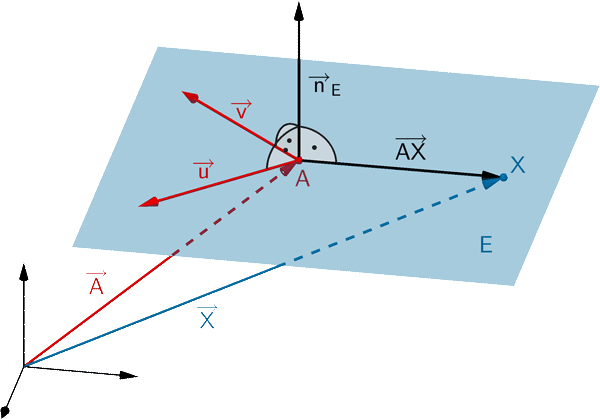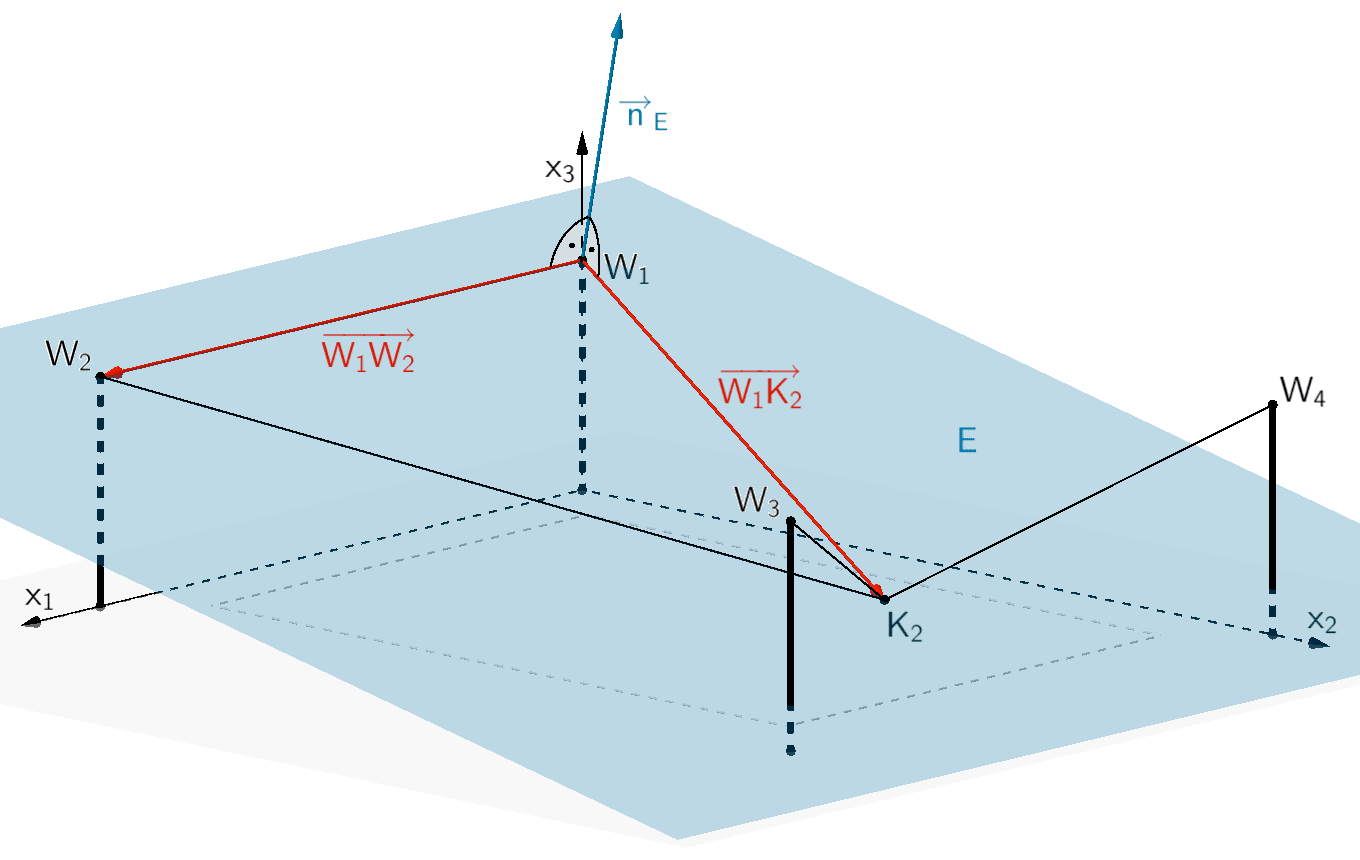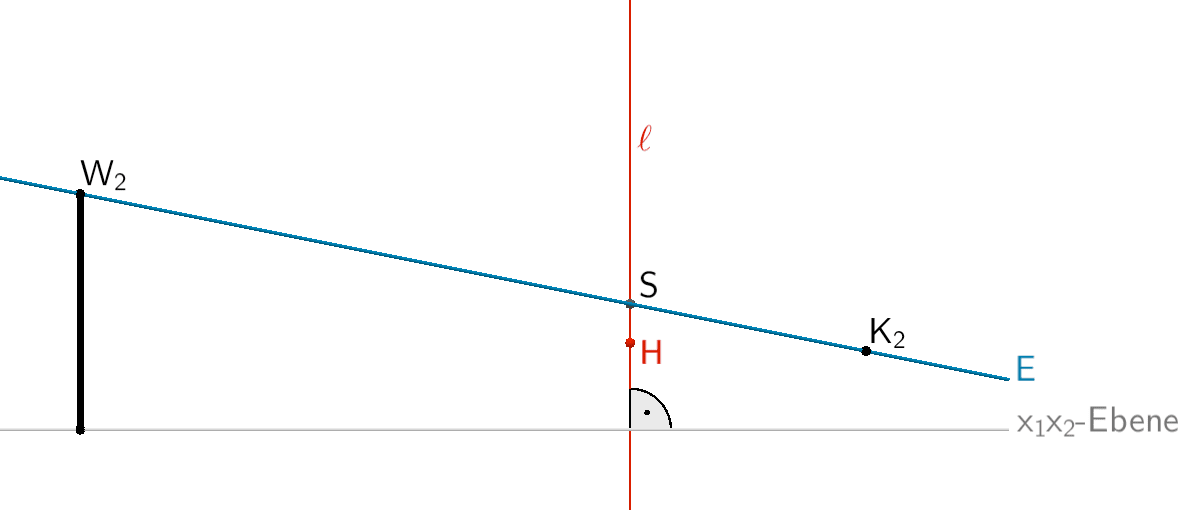Der Torwart führt den Abstoß aus. Der höchste Punkt der Flugbahn des Balls wird im Modell durch den Punkt \(H(50|70|15)\) beschrieben.
Ermitteln Sie eine Gleichung der durch die Punkte \(W_{1}\), \(W_{2}\) und \(K_{2}\) festgelegten Ebene \(E\) in Normalenform und weisen Sie nach, dass \(H\) unterhalb von \(E\) liegt.
(Mögliches Teilergebnis: \(E \colon x_{2} + 5x_{3} - 150 = 0\))
(7 BE)
Lösung zu Teilaufgabe d
Ebenengleichung in Normalenform, Lotgerade, Schnittpunkt Gerade - Ebene
Gleichung der Ebene \(E\) in Normalenform
Ebenengleichung in Normalenform (vgl. Merkhilfe)
Jede Ebene lässt sich durch eine Gleichung in Normalenform beschreiben. Ist \(A\) ein beliebiger Aufpunkt der Ebene \(E\) und \(\overrightarrow{n}_{E}\) ein Normalenvektor von \(E\), so erfüllt jeder Punkt \(X\) der Ebene \(E\) folgende Gleichungen:
Normalenform in Vektordarstellung
\[E \colon \overrightarrow{n}_{E} \circ (\overrightarrow{X} - \overrightarrow{A}) = 0\]

Normalenform in Koordinatendarstellung
\[E \colon n_{1}x_{1} + n_{2}x_{2} + n_{3}x_{3} + n_{0} = 0\]
mit \(n_{0} = -(\overrightarrow{n}_{E} \circ \overrightarrow{A}) = - \: n_{1}a_{1} - n_{2}a_{2} - n_{3}a_{3}\)
\(n_{1}\), \(n_{2}\) und \(n_{3}\): Koordinaten eines Normalenvektors \(\overrightarrow{n}_{E}\)

Beispielsweise legen die beiden linear unabhängigen Verbindungsvektoren \(\overrightarrow{W_{1}W_{2}}\) und \(\overrightarrow{W_{1}K_{2}}\) die Ebene \(E\) fest. Das Vektorprodukt der Verbindungsvektoren liefert einen Normalenvektor \(\overrightarrow{n}_{E}\) der Ebene \(E\). Als Aufpunkt wählt man einen der gegebenen Punkte \(W_{1}\), \(W_{2}\) oder \(K_{2}\). Damit lässt sich eine Gleichung der Ebene \(E\) in Normalenform angeben. Der Ansatz kann mithilfe der Normalenform in Vektordarstellung oder in Koordinatendarstellung erfolgen. Die Aufgabenstellung nennt als mögliches Ergebnis eine Gleichung der Ebene \(E\) in Normalenform in Koordinatendarstellung.
Linear unabhängige Verbindungsvektoren \(\overrightarrow{W_{1}W_{2}}\) und \(W_{1}K_{2}\) bestimmen:
\(W_{1}(0|0|30)\), \(W_{2}(90|0|30)\), \(K_{2}(51|100|10)\)
\[\overrightarrow{W_{1}W_{2}} = \overrightarrow{W_{2}} - \overrightarrow{W_{1}} = \begin{pmatrix} 90 \\ 0 \\ 30 \end{pmatrix} - \begin{pmatrix} 0 \\ 0 \\ 30 \end{pmatrix} = \begin{pmatrix} 90 \\ 0 \\ 0 \end{pmatrix}\]
\[\overrightarrow{W_{1}K_{2}} = \overrightarrow{K_{2}} - \overrightarrow{W_{1}} = \begin{pmatrix} 51 \\ 100 \\ 10 \end{pmatrix} - \begin{pmatrix} 0 \\ 0 \\ 30 \end{pmatrix} = \begin{pmatrix} 51 \\ 100 \\ -20 \end{pmatrix}\]
Normalenvektor \(\overrightarrow{n}_{E}\) der Ebene \(E\) ermitteln:
Vektorprodukt (Kreuzprodukt)
Das Vektorprodukt \(\overrightarrow{a} \times \overrightarrow{b}\) zweier Vektoren \(\overrightarrow{a}\) und \(\overrightarrow{b}\) erzeugt einen neuen Vektor \(\overrightarrow{c} = \overrightarrow{a} \times \overrightarrow{b}\) mit den Eigenschaften:
\(\overrightarrow{c}\) ist sowohl zu \(\overrightarrow{a}\) als auch zu \(\overrightarrow{b}\) senkrecht.
\[\overrightarrow{c} = \overrightarrow{a} \times \overrightarrow{b} \quad \Longrightarrow \quad \overrightarrow{c} \perp \overrightarrow{a}, \enspace \overrightarrow{c} \perp \overrightarrow{b}\]
Der Betrag des Vektorprodukts zweier Vektoren \(\overrightarrow{a}\) und \(\overrightarrow{b}\) ist gleich dem Produkt aus den Beträgen der Vektoren \(\overrightarrow{a}\) und \(\overrightarrow{b}\) und dem Sinus des von ihnen eingeschlossenen Winkels \(\varphi\).
\[\vert \overrightarrow{a} \times \overrightarrow{b} \vert = \vert \overrightarrow{a} \vert \cdot \vert \overrightarrow{b} \vert \cdot \sin{\varphi} \quad (0^{\circ} \leq \varphi \leq 180^{\circ})\]
Die Vektoren \(\overrightarrow{a}\), \(\overrightarrow{b}\) und \(\overrightarrow{c}\) bilden in dieser Reihenfolge ein Rechtssystem. Rechtehandregel: Weist \(\overrightarrow{a}\) in Richtung des Daumens und \(\overrightarrow{b}\) in Richtung des Zeigefingers, dann weist \(\overrightarrow{c} = \overrightarrow{a} \times \overrightarrow{b}\) in Richtung des Mittelfingers.
Berechnung eines Vektorprodukts im \(\boldsymbol{\mathbb R^{3}}\) (vgl. Merkhilfe)
\[\overrightarrow{a} \times \overrightarrow{b} = \begin {pmatrix} a_1 \\ a_2 \\ a_3 \end {pmatrix} \times \begin {pmatrix} b_1 \\ b_2 \\ b_3 \end {pmatrix} = \begin {pmatrix} a_2 \cdot b_3 - a_3 \cdot b_2 \\ a_3 \cdot b_1 - a_1 \cdot b_3 \\ a_1 \cdot b_2 - a_2 \cdot b_1 \end {pmatrix}\]
\[\begin{align*} \overrightarrow{W_{1}W_{2}} \times \overrightarrow{W_{1}K_{2}} &= \begin{pmatrix} 90 \\ 0 \\ 0 \end{pmatrix} \times \begin{pmatrix} 51 \\ 100 \\ -20 \end{pmatrix} \\[0.8em] &= \begin{pmatrix} 0 & \cdot & (-2) & - & 0 & \cdot & 100 \\ 0 & \cdot & 51 & - & 90 & \cdot & (-20) \\ 90 & \cdot & 100 & - & 0 & \cdot & 51 \end{pmatrix} \\[0.8em] &= \begin{pmatrix} 0 \\ 90 \cdot 20 \\ 90 \cdot 100 \end{pmatrix} \\[0.8em] &= 90 \cdot 20 \cdot \begin{pmatrix} 0 \\ 1 \\ 5 \end{pmatrix} \end{align*}\]
\[\Longrightarrow \quad \overrightarrow{n}_{E} = \begin{pmatrix} 0 \\ 1 \\ 5 \end{pmatrix}\]
Gleichung der Ebene \(E\) in Normalenform formulieren:
1. Möglichkeit: Ansatz mit der Normalenform in Vektordarstellung
Ebenengleichung in Normalenform (vgl. Merkhilfe)
Jede Ebene lässt sich durch eine Gleichung in Normalenform beschreiben. Ist \(A\) ein beliebiger Aufpunkt der Ebene \(E\) und \(\overrightarrow{n}_{E}\) ein Normalenvektor von \(E\), so erfüllt jeder Punkt \(X\) der Ebene \(E\) folgende Gleichungen:
Normalenform in Vektordarstellung
\[E \colon \overrightarrow{n}_{E} \circ (\overrightarrow{X} - \overrightarrow{A}) = 0\]

Normalenform in Koordinatendarstellung
\[E \colon n_{1}x_{1} + n_{2}x_{2} + n_{3}x_{3} + n_{0} = 0\]
mit \(n_{0} = -(\overrightarrow{n}_{E} \circ \overrightarrow{A}) = - \: n_{1}a_{1} - n_{2}a_{2} - n_{3}a_{3}\)
\(n_{1}\), \(n_{2}\) und \(n_{3}\): Koordinaten eines Normalenvektors \(\overrightarrow{n}_{E}\)
Es sei \(W_{1}\) der Aufpunkt der Ebene \(E\).
\(\overrightarrow{n}_{E} = \begin{pmatrix} 0 \\ 1 \\ 5 \end{pmatrix}\), \(W_{1}(0|0|30)\)
\[E \colon \overrightarrow{n}_{E} \circ \left( \overrightarrow{X} - \overrightarrow{W_{1}} \right) = 0\]
\[E \colon \begin{pmatrix} 0 \\ 1 \\ 5 \end{pmatrix} \circ \left[ \overrightarrow{X} - \begin{pmatrix} 0 \\ 0 \\ 30 \end{pmatrix} \right] = 0\]
Ggf. wandelt man die Ebenengleichung in Normalenform in Vektordarstellung in die Koordinatendarstellung um. Hierfür wird das Skalarprodukt ausmultipliziert.
Skalarprodukt
Unter dem Skalarprodukt \(\overrightarrow{a} \circ \overrightarrow{b}\) zweier Vektoren \(\overrightarrow{a}\) und \(\overrightarrow{b}\) versteht man das Produkt aus den Beträgen der beiden Vektoren und dem Kosinus des von den Vektoren eingeschlossenen Winkels \(\varphi\).
\[\overrightarrow{a} \circ \overrightarrow{b} = \vert \overrightarrow{a} \vert \cdot \vert \overrightarrow{b} \vert \cdot \cos{\varphi} \quad (0^{\circ} \leq \varphi \leq 180^{\circ})\]
Berechnung eines Skalarprodukts im \(\boldsymbol{\mathbb R^{3}}\) (vgl. Merkhilfe)
\[\overrightarrow{a} \circ \overrightarrow{b} = \begin{pmatrix} a_{1} \\ a_{2} \\ a_{3} \end{pmatrix} \circ \begin{pmatrix} b_{1} \\ b_{2} \\ b_{3} \end{pmatrix} = a_{1}b_{1} + a_{2}b_{2} + a_{3}b_{3}\]
\[\begin{align*} \begin{pmatrix} 0 \\ 1 \\ 5 \end{pmatrix} \circ \left[ \overrightarrow{X} - \begin{pmatrix} 0 \\ 0 \\ 30 \end{pmatrix} \right] &= 0 \\[0.8em] 0 \cdot (x_{1} - 0) + 1 \cdot (x_{2} - 0) + 5 \cdot (x_{3} - 30) &= 0 \\[0.8em] x_{2} + 5x_{3} - 150 &= 0 \end{align*}\]
\[\Longrightarrow \quad E \colon x_{2} + 5x_{3} - 150 = 0\]
2. Möglichkeit: Ansatz mit der Normalenform in Koordinatendarstellung
Ebenengleichung in Normalenform (vgl. Merkhilfe)
Jede Ebene lässt sich durch eine Gleichung in Normalenform beschreiben. Ist \(A\) ein beliebiger Aufpunkt der Ebene \(E\) und \(\overrightarrow{n}_{E}\) ein Normalenvektor von \(E\), so erfüllt jeder Punkt \(X\) der Ebene \(E\) folgende Gleichungen:
Normalenform in Vektordarstellung
\[E \colon \overrightarrow{n}_{E} \circ (\overrightarrow{X} - \overrightarrow{A}) = 0\]

Normalenform in Koordinatendarstellung
\[E \colon n_{1}x_{1} + n_{2}x_{2} + n_{3}x_{3} + n_{0} = 0\]
mit \(n_{0} = -(\overrightarrow{n}_{E} \circ \overrightarrow{A}) = - \: n_{1}a_{1} - n_{2}a_{2} - n_{3}a_{3}\)
\(n_{1}\), \(n_{2}\) und \(n_{3}\): Koordinaten eines Normalenvektors \(\overrightarrow{n}_{E}\)
Es sei \(W_{1}\) der Aufpunkt der Ebene \(E\).
\(\overrightarrow{n}_{E} = \begin{pmatrix} 0 \\ 1 \\ 5 \end{pmatrix}\), \(W_{1}(0|0|30)\)
\[E \colon n_{1}x_{1} + n_{2}x_{2} + n_{3}x_{3} + n_{0} = 0\]
\[E \colon x_{2} + 5x_{3} + n_{0} = 0\]
\[\begin{align*}W_{1} \in E \colon 0 + 5 \cdot 30 + n_{0} &= 0 \\[0.8em] 150 + n_{0} &= 0 & &| -150 \\[0.8em] n_{0} &= -150 \end{align*}\]
\[\Longrightarrow \quad E \colon x_{2} + 5x_{3} - 150 = 0\]
Nachweis, dass der Punkt \(H\) unterhalb der Ebene \(E\) liegt
1. Lösungsansatz: Punktprobe \(P \in E\) eines Punktes \(P\) vertikal zu \(H\)

Ein Punkt \(P\), der vertikal zu Punkt \(H\) und in der Ebene \(E\) liegt, hat die gleiche \(x_{1}\)- und \(x_{2}\)-Koordinate wie Punkt \(H\). Mithilfe einer Punktprobe \(P \in E\) lässt sich die \(x_{3}\)-Koordinate des Punktes \(P\) ermitteln. Ein Vergleich der \(x_{3}\)-Koordinaten der Punkte \(H\) und \(P\) lässt auf die Lage des Punktes \(H\) bezüglich der Ebene \(E\) schließen. Der Punkt \(H\) liegt unterhalb der Ebene \(E\), wenn \(x_{3_{H}} < x_{3_{P}}\) gilt.
\[H(50|70|15) \quad \Longrightarrow \quad P(50|70|p_{3})\]
Koordinate \(p_{3}\) durch Punktprobe \(P \in E\) ermitteln:
\[P(50|70|p_{3})\]
\[E \colon x_{2} + 5x_{3} - 150 = 0\]
\[\begin{align*}P \in E \colon 70 + 5 \cdot p_{3} - 150 &= 0 \\[0.8em] 5p_{3} - 80 &= 0 & &| + 80 \\[0.8em] 5p_{3} &= 80 & &| : 5 \\[0.8em] p_{3} &= 16 \end{align*}\]
\[\Longrightarrow \quad P(50|70|16)\]
\(x_{3}\)-Koordinaten der Punkte \(H\) und \(P\) vergleichen:
\(H(50|70|15)\), \(P(50|70|16)\)
\[\Longrightarrow \quad X_{3_{H}} < x_{3_{P}}\]
Damit liegt der Punkt \(H\) unterhalb der Ebene \(E\).
2. Lösungsansatz: Lotgerade durch \(H\) auf die \(x_{1}x_{2}\)-Ebene

Planskizze: Die Lotgerade \(\ell\) auf die \(x_{1}x_{2}-Ebene\), welche durch den Punkt \(H\) verläuft, schneidet die Ebene \(E\) im Punkt \(S\). Ein Vergleich der \(x_{3}\)-Koordinaten der Punkte \(H\) und \(S\) lässt auf die Lage des Punktes \(H\) bezüglich der Ebene \(E\) schließen. Der Punkt \(H\) liegt unterhalb der Ebene \(E\), wenn \(x_{3_{H}} < x_{3_{S}}\) gilt.
Gleichung der Lotgeraden \(\ell\) aufstellen:
Lotgerade auf eine Ebene
\[E\,\colon \overrightarrow{n}_E \circ (\overrightarrow{X} - \overrightarrow{A}) = 0; \quad P\,(p_1|p_2|p_3)\]
Die Lotgerade \(\ell\) mit \(P \in \ell\) auf eine Ebene \(E\) ist durch den Ortsvektor \(\overrightarrow{P}\) und den Normalenvektor \(\overrightarrow{n}_E\) eindeutig bestimmt:
\[\ell\,\colon \overrightarrow{X} = \overrightarrow{P} + \lambda \cdot \overrightarrow{n}_E; \; \lambda \in \mathbb R\]
Die Lotgerade \(\ell\) auf die \(x_{1}x_{2}\)-Ebene mit \(H \in \ell\) ist durch den Ortsvektor \(\overrightarrow{H}\) und einen Normalenvektor \(\overrightarrow{n}\) der \(x_{1}x_{2}\)-Ebene eindeutig bestimmt.
\(H(50|70|15)\), \(\overrightarrow{n} = \begin{pmatrix} 0 \\ 0 \\ 1 \end{pmatrix}\)
\[\ell \colon \overrightarrow{X} = \overrightarrow{H} + \mu \cdot \overrightarrow{n}, \; \mu \in \mathbb R\]
\[\ell \colon \overrightarrow{X} = \begin{pmatrix} 40 \\ 70 \\ 15 \end{pmatrix} + \mu \cdot \begin{pmatrix} 0 \\ 0 \\ 1 \end{pmatrix}, \; \mu \in \mathbb R\]
Schnittpunkt \(S\) der Lotgeraden \(\ell\) mit der Ebene \(E\) ermitteln:
\[\ell \colon \overrightarrow{X} = \begin{pmatrix} 40 \\ 70 \\ 15 \end{pmatrix} + \mu \cdot \begin{pmatrix} 0 \\ 0 \\ 1 \end{pmatrix}\]
\[E \colon x_{2} + 5x_{3} - 150 = 0\]
\[\begin{align*} \ell \cap E \colon 70 + 5 \cdot (15 + \mu) - 150 &= 0 \\[0.8em] 70 + 75 + 5\mu - 150 &= 0 \\[0.8em] 5\mu - 5 &= 0 & &| + 5 \\[0.8em] 5\mu &= 5 & &| : 5 \\[0.8em] \mu &= 1 \end{align*}\]
Parameterwert \(\mu = 1\) in die Gleichung der Lotgeraden \(\ell\) einsetzen:
\[S \in \ell: \overrightarrow{S} = \begin{pmatrix} 40 \\ 70 \\ 15 \end{pmatrix} + 1 \cdot \begin{pmatrix} 0 \\ 0 \\ 1 \end{pmatrix} = \begin{pmatrix} 50 \\ 70 \\ 16 \end{pmatrix}\]
\[\Longrightarrow \quad S(50|70|16)\]
\(x_{3}\)-Koordinaten der Punkte \(H\) und \(S\) vergleichen:
\(H(50|70|15)\), \(S(50|70|16)\)
\[\Longrightarrow \quad X_{3_{H}} < x_{3_{S}}\]
Damit liegt der Punkt \(H\) unterhalb der Ebene \(E\).


